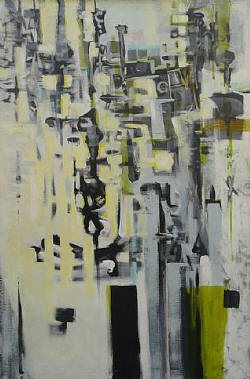|
Bryan Wynter
Bryan Wynter was born in London on 8 September 1915. He studied at the
Slade School between 1938 and 1940. A conscientious objector during the
war, Wynter worked on the land around Oxford as well as assisting Solly
Zuckermanís research at the Department of Primates, Oxford University.
Depressed by his menial work and his involvement with Zuckermanís
vivisection experiments, Wynter moved to St Ives in 1945.
 He settled at
the Carn, Zennor, a run-down rustic cottage on the harsh moors of the
northern Cornish coast. On arriving in Cornwall, Wynter immediately
immersed himself in the natural environment, pursuing activities such as
walking, climbing, canoeing and swimming. This deep involvement with
landscape and natural process would remain with him throughout his life. He settled at
the Carn, Zennor, a run-down rustic cottage on the harsh moors of the
northern Cornish coast. On arriving in Cornwall, Wynter immediately
immersed himself in the natural environment, pursuing activities such as
walking, climbing, canoeing and swimming. This deep involvement with
landscape and natural process would remain with him throughout his life.
Wynter involved himself with the artistic community in Cornwall, and in
1946 he co-founded the Crypt Group, so-called because they exhibited (in
1946 and 48) in the basement of the deconsecrated Marinerís Church,
beneath the St Ives Society of Artists. He later became a member of the
Penwith Society of Artists.
Wynter worked on small-scale gouaches during the 1940s, his first solo
exhibition taking place at the Redfern Gallery, London, in 1947. He
married Susan Letherbridge in 1949 and between 1951 and 1956 taught at
Bath Academy of Art, Corsham. Wynter took advantage of a legacy to give
up teaching in 1956 and rented a studio in London for ten months. It was
during this period that Wynter began his first non-figurative paintings,
perhaps influenced by the show of American Abstract Expressionism at the
Tate. In 1959 he married Monica
Harman. In 1960 he began to translate his concerns into
three-dimensions, creating his IMOOS (Images Moving Out Onto Space).
These kinetic constructions did not replace Wynter's two-dimensional
work, but rather can be seen as an extension of it.
Wynter suffered a heart attack in 1961 and in 1964 moved off the moors
to Treverven at St Buryan, a village between Penzance and Lands End. He
continued to create art until shortly before his death in Penzance on 11
February 1975.
|

